Curtin UniReady Foundations of Communication: Topic 1 Overview
VerifiedAdded on 2019/10/12
|11
|3813
|332
Homework Assignment
AI Summary
This assignment is an introductory module to the Foundations of Communication unit within the UniReady program at Curtin University. The assignment covers essential aspects of academic life, including understanding the unit's structure, expectations, and the importance of effective communication. It emphasizes the significance of academic integrity, explaining the core values of honesty, trust, fairness, respect, and responsibility. The assignment also delves into the practical aspects of communication, particularly focusing on netiquette for email correspondence and the use of discussion boards. Students are guided on how to contact tutors, the importance of using their Curtin email, and maintaining a professional tone. Furthermore, the assignment provides resources and guidelines on academic integrity, referencing styles (APA 6th edition), and the avoidance of plagiarism. Students are encouraged to familiarize themselves with the Curtin University library resources and to engage with their peers through online platforms, such as the Discussion Board, to foster a supportive learning environment. Activities, such as creating a VOKI, are included to encourage student interaction and self-expression. The assignment sets a foundation for successful university studies, ensuring students understand the necessary communication skills and ethical standards.
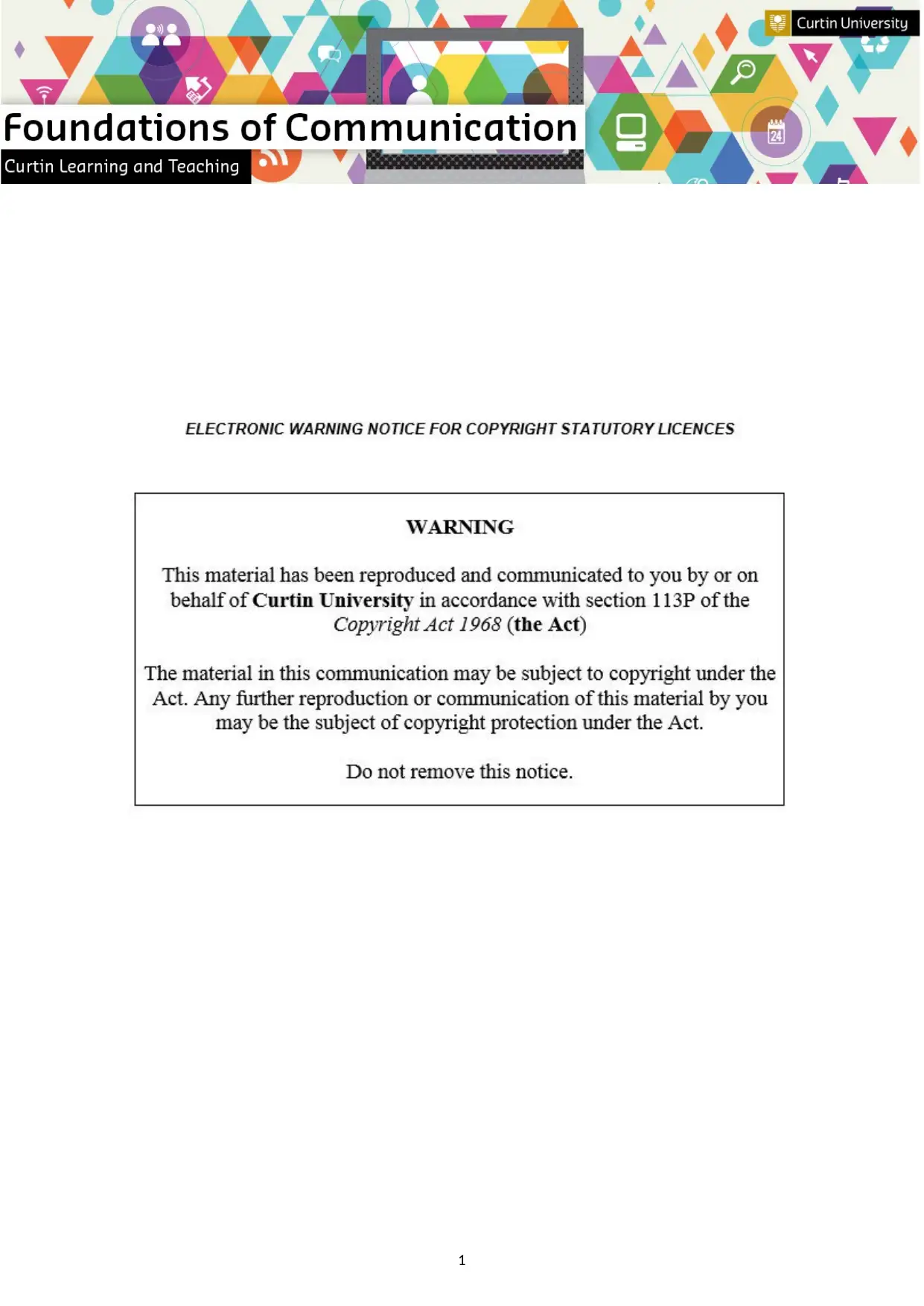
1
Paraphrase This Document
Need a fresh take? Get an instant paraphrase of this document with our AI Paraphraser
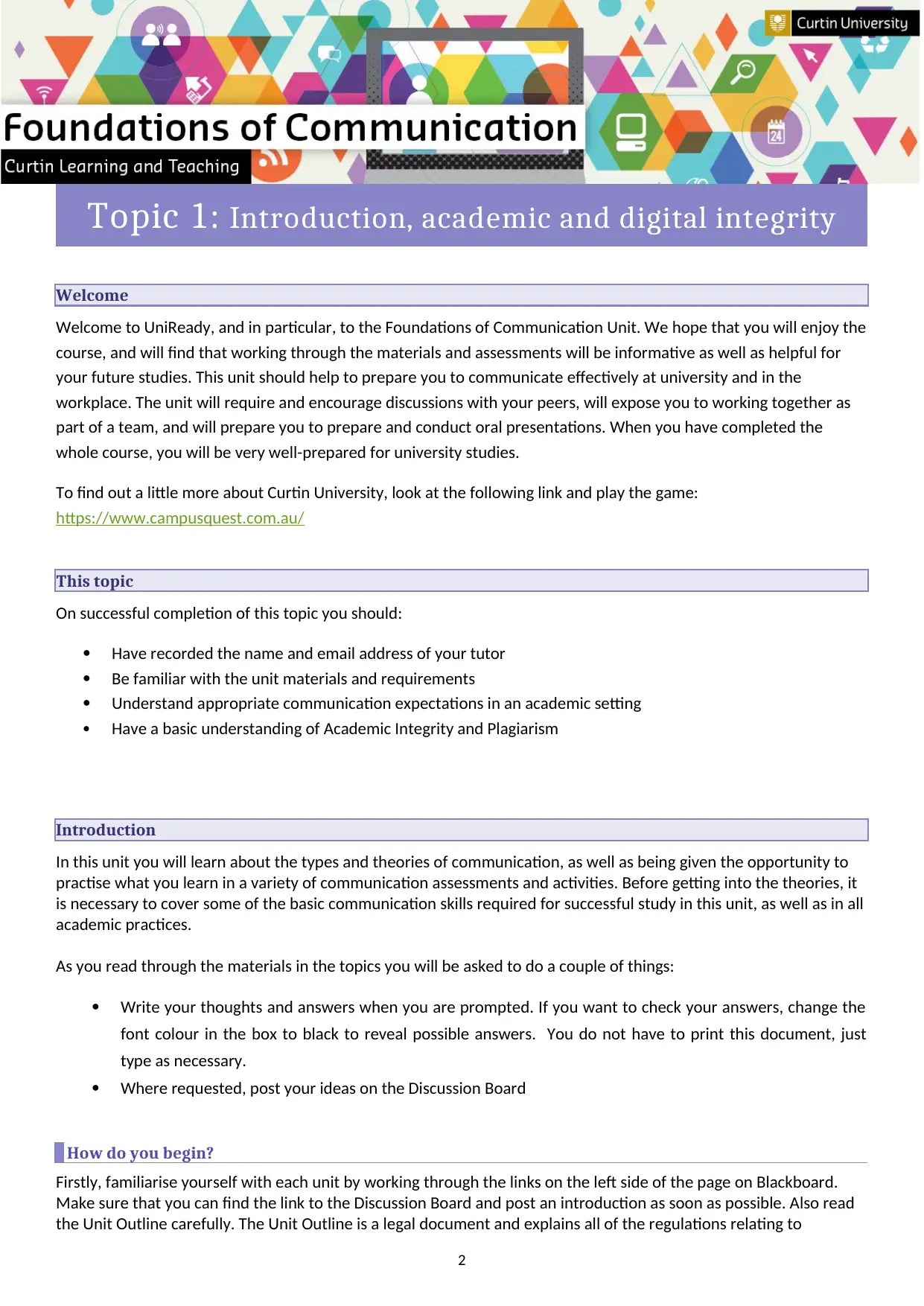
Topic 1: Introduction, academic and digital integrity
Welcome
Welcome to UniReady, and in particular, to the Foundations of Communication Unit. We hope that you will enjoy the
course, and will find that working through the materials and assessments will be informative as well as helpful for
your future studies. This unit should help to prepare you to communicate effectively at university and in the
workplace. The unit will require and encourage discussions with your peers, will expose you to working together as
part of a team, and will prepare you to prepare and conduct oral presentations. When you have completed the
whole course, you will be very well-prepared for university studies.
To find out a little more about Curtin University, look at the following link and play the game:
https://www.campusquest.com.au/
This topic
On successful completion of this topic you should:
Have recorded the name and email address of your tutor
Be familiar with the unit materials and requirements
Understand appropriate communication expectations in an academic setting
Have a basic understanding of Academic Integrity and Plagiarism
Introduction
In this unit you will learn about the types and theories of communication, as well as being given the opportunity to
practise what you learn in a variety of communication assessments and activities. Before getting into the theories, it
is necessary to cover some of the basic communication skills required for successful study in this unit, as well as in all
academic practices.
As you read through the materials in the topics you will be asked to do a couple of things:
Write your thoughts and answers when you are prompted. If you want to check your answers, change the
font colour in the box to black to reveal possible answers. You do not have to print this document, just
type as necessary.
Where requested, post your ideas on the Discussion Board
How do you begin?
Firstly, familiarise yourself with each unit by working through the links on the left side of the page on Blackboard.
Make sure that you can find the link to the Discussion Board and post an introduction as soon as possible. Also read
the Unit Outline carefully. The Unit Outline is a legal document and explains all of the regulations relating to
2
Welcome
Welcome to UniReady, and in particular, to the Foundations of Communication Unit. We hope that you will enjoy the
course, and will find that working through the materials and assessments will be informative as well as helpful for
your future studies. This unit should help to prepare you to communicate effectively at university and in the
workplace. The unit will require and encourage discussions with your peers, will expose you to working together as
part of a team, and will prepare you to prepare and conduct oral presentations. When you have completed the
whole course, you will be very well-prepared for university studies.
To find out a little more about Curtin University, look at the following link and play the game:
https://www.campusquest.com.au/
This topic
On successful completion of this topic you should:
Have recorded the name and email address of your tutor
Be familiar with the unit materials and requirements
Understand appropriate communication expectations in an academic setting
Have a basic understanding of Academic Integrity and Plagiarism
Introduction
In this unit you will learn about the types and theories of communication, as well as being given the opportunity to
practise what you learn in a variety of communication assessments and activities. Before getting into the theories, it
is necessary to cover some of the basic communication skills required for successful study in this unit, as well as in all
academic practices.
As you read through the materials in the topics you will be asked to do a couple of things:
Write your thoughts and answers when you are prompted. If you want to check your answers, change the
font colour in the box to black to reveal possible answers. You do not have to print this document, just
type as necessary.
Where requested, post your ideas on the Discussion Board
How do you begin?
Firstly, familiarise yourself with each unit by working through the links on the left side of the page on Blackboard.
Make sure that you can find the link to the Discussion Board and post an introduction as soon as possible. Also read
the Unit Outline carefully. The Unit Outline is a legal document and explains all of the regulations relating to
2
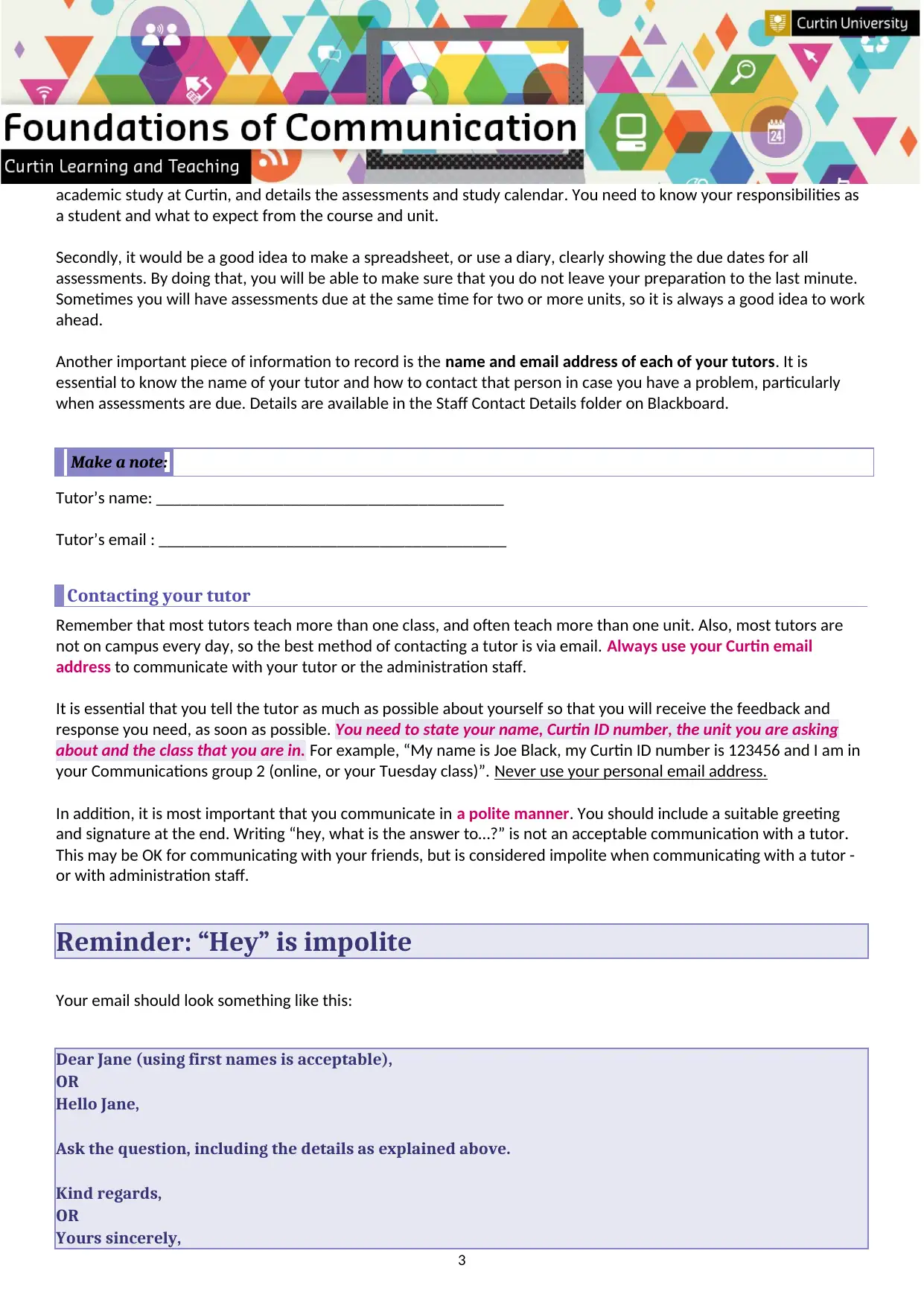
academic study at Curtin, and details the assessments and study calendar. You need to know your responsibilities as
a student and what to expect from the course and unit.
Secondly, it would be a good idea to make a spreadsheet, or use a diary, clearly showing the due dates for all
assessments. By doing that, you will be able to make sure that you do not leave your preparation to the last minute.
Sometimes you will have assessments due at the same time for two or more units, so it is always a good idea to work
ahead.
Another important piece of information to record is the name and email address of each of your tutors. It is
essential to know the name of your tutor and how to contact that person in case you have a problem, particularly
when assessments are due. Details are available in the Staff Contact Details folder on Blackboard.
Make a note:
Tutor’s name: _________________________________________
Tutor’s email : _________________________________________
Contacting your tutor
Remember that most tutors teach more than one class, and often teach more than one unit. Also, most tutors are
not on campus every day, so the best method of contacting a tutor is via email. Always use your Curtin email
address to communicate with your tutor or the administration staff.
It is essential that you tell the tutor as much as possible about yourself so that you will receive the feedback and
response you need, as soon as possible. You need to state your name, Curtin ID number, the unit you are asking
about and the class that you are in. For example, “My name is Joe Black, my Curtin ID number is 123456 and I am in
your Communications group 2 (online, or your Tuesday class)”. Never use your personal email address.
In addition, it is most important that you communicate in a polite manner. You should include a suitable greeting
and signature at the end. Writing “hey, what is the answer to…?” is not an acceptable communication with a tutor.
This may be OK for communicating with your friends, but is considered impolite when communicating with a tutor -
or with administration staff.
Reminder: “Hey” is impolite
Your email should look something like this:
Dear Jane (using first names is acceptable),
OR
Hello Jane,
Ask the question, including the details as explained above.
Kind regards,
OR
Yours sincerely,
3
a student and what to expect from the course and unit.
Secondly, it would be a good idea to make a spreadsheet, or use a diary, clearly showing the due dates for all
assessments. By doing that, you will be able to make sure that you do not leave your preparation to the last minute.
Sometimes you will have assessments due at the same time for two or more units, so it is always a good idea to work
ahead.
Another important piece of information to record is the name and email address of each of your tutors. It is
essential to know the name of your tutor and how to contact that person in case you have a problem, particularly
when assessments are due. Details are available in the Staff Contact Details folder on Blackboard.
Make a note:
Tutor’s name: _________________________________________
Tutor’s email : _________________________________________
Contacting your tutor
Remember that most tutors teach more than one class, and often teach more than one unit. Also, most tutors are
not on campus every day, so the best method of contacting a tutor is via email. Always use your Curtin email
address to communicate with your tutor or the administration staff.
It is essential that you tell the tutor as much as possible about yourself so that you will receive the feedback and
response you need, as soon as possible. You need to state your name, Curtin ID number, the unit you are asking
about and the class that you are in. For example, “My name is Joe Black, my Curtin ID number is 123456 and I am in
your Communications group 2 (online, or your Tuesday class)”. Never use your personal email address.
In addition, it is most important that you communicate in a polite manner. You should include a suitable greeting
and signature at the end. Writing “hey, what is the answer to…?” is not an acceptable communication with a tutor.
This may be OK for communicating with your friends, but is considered impolite when communicating with a tutor -
or with administration staff.
Reminder: “Hey” is impolite
Your email should look something like this:
Dear Jane (using first names is acceptable),
OR
Hello Jane,
Ask the question, including the details as explained above.
Kind regards,
OR
Yours sincerely,
3
⊘ This is a preview!⊘
Do you want full access?
Subscribe today to unlock all pages.

Trusted by 1+ million students worldwide
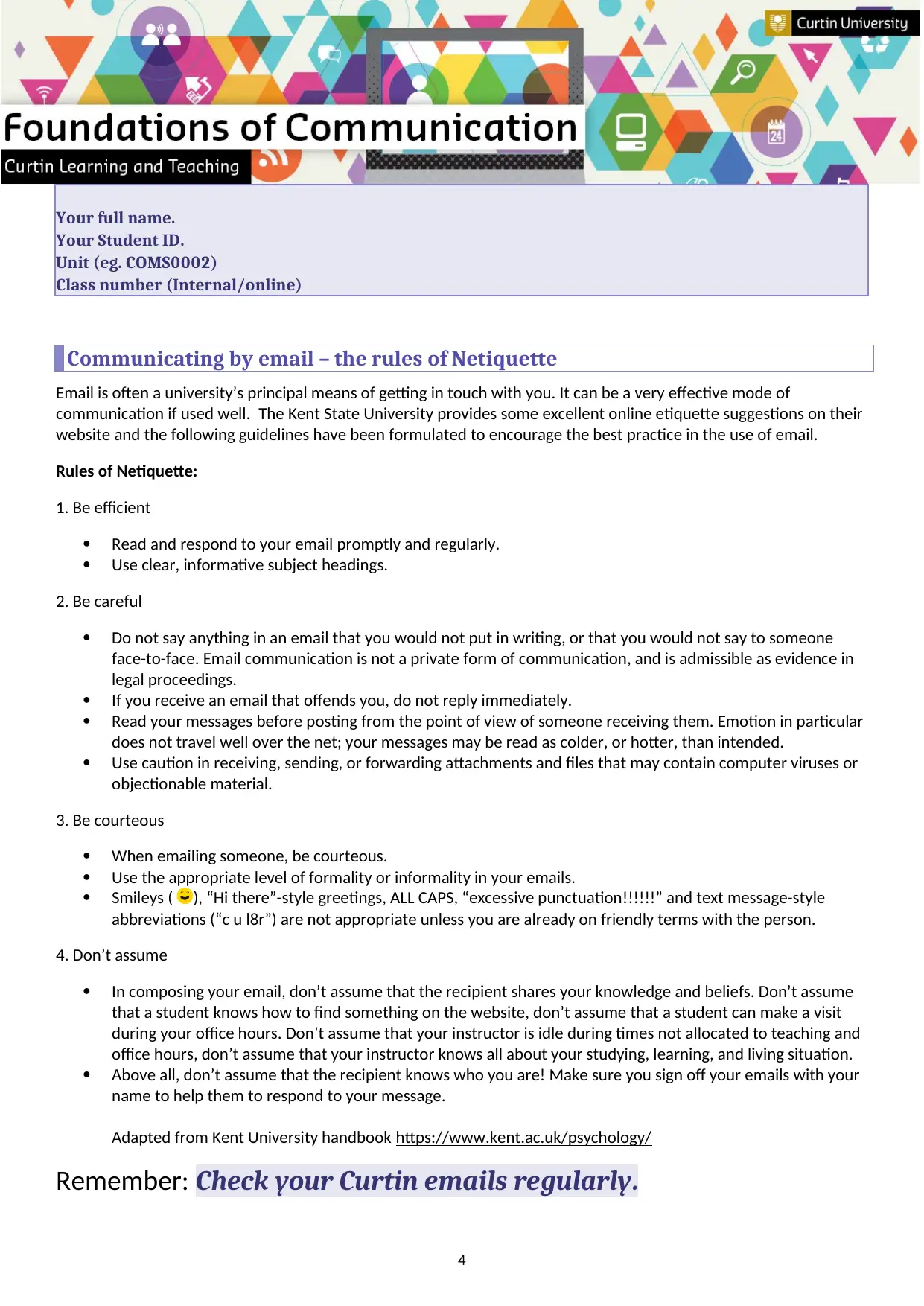
Your full name.
Your Student ID.
Unit (eg. COMS0002)
Class number (Internal/online)
Communicating by email – the rules of Netiquette
Email is often a university’s principal means of getting in touch with you. It can be a very effective mode of
communication if used well. The Kent State University provides some excellent online etiquette suggestions on their
website and the following guidelines have been formulated to encourage the best practice in the use of email.
Rules of Netiquette:
1. Be efficient
Read and respond to your email promptly and regularly.
Use clear, informative subject headings.
2. Be careful
Do not say anything in an email that you would not put in writing, or that you would not say to someone
face-to-face. Email communication is not a private form of communication, and is admissible as evidence in
legal proceedings.
If you receive an email that offends you, do not reply immediately.
Read your messages before posting from the point of view of someone receiving them. Emotion in particular
does not travel well over the net; your messages may be read as colder, or hotter, than intended.
Use caution in receiving, sending, or forwarding attachments and files that may contain computer viruses or
objectionable material.
3. Be courteous
When emailing someone, be courteous.
Use the appropriate level of formality or informality in your emails.
Smileys ( ), “Hi there”-style greetings, ALL CAPS, “excessive punctuation!!!!!!” and text message-style
abbreviations (“c u l8r”) are not appropriate unless you are already on friendly terms with the person.
4. Don’t assume
In composing your email, don’t assume that the recipient shares your knowledge and beliefs. Don’t assume
that a student knows how to find something on the website, don’t assume that a student can make a visit
during your office hours. Don’t assume that your instructor is idle during times not allocated to teaching and
office hours, don’t assume that your instructor knows all about your studying, learning, and living situation.
Above all, don’t assume that the recipient knows who you are! Make sure you sign off your emails with your
name to help them to respond to your message.
Adapted from Kent University handbook https://www.kent.ac.uk/psychology/
Remember: Check your Curtin emails regularly.
4
Your Student ID.
Unit (eg. COMS0002)
Class number (Internal/online)
Communicating by email – the rules of Netiquette
Email is often a university’s principal means of getting in touch with you. It can be a very effective mode of
communication if used well. The Kent State University provides some excellent online etiquette suggestions on their
website and the following guidelines have been formulated to encourage the best practice in the use of email.
Rules of Netiquette:
1. Be efficient
Read and respond to your email promptly and regularly.
Use clear, informative subject headings.
2. Be careful
Do not say anything in an email that you would not put in writing, or that you would not say to someone
face-to-face. Email communication is not a private form of communication, and is admissible as evidence in
legal proceedings.
If you receive an email that offends you, do not reply immediately.
Read your messages before posting from the point of view of someone receiving them. Emotion in particular
does not travel well over the net; your messages may be read as colder, or hotter, than intended.
Use caution in receiving, sending, or forwarding attachments and files that may contain computer viruses or
objectionable material.
3. Be courteous
When emailing someone, be courteous.
Use the appropriate level of formality or informality in your emails.
Smileys ( ), “Hi there”-style greetings, ALL CAPS, “excessive punctuation!!!!!!” and text message-style
abbreviations (“c u l8r”) are not appropriate unless you are already on friendly terms with the person.
4. Don’t assume
In composing your email, don’t assume that the recipient shares your knowledge and beliefs. Don’t assume
that a student knows how to find something on the website, don’t assume that a student can make a visit
during your office hours. Don’t assume that your instructor is idle during times not allocated to teaching and
office hours, don’t assume that your instructor knows all about your studying, learning, and living situation.
Above all, don’t assume that the recipient knows who you are! Make sure you sign off your emails with your
name to help them to respond to your message.
Adapted from Kent University handbook https://www.kent.ac.uk/psychology/
Remember: Check your Curtin emails regularly.
4
Paraphrase This Document
Need a fresh take? Get an instant paraphrase of this document with our AI Paraphraser
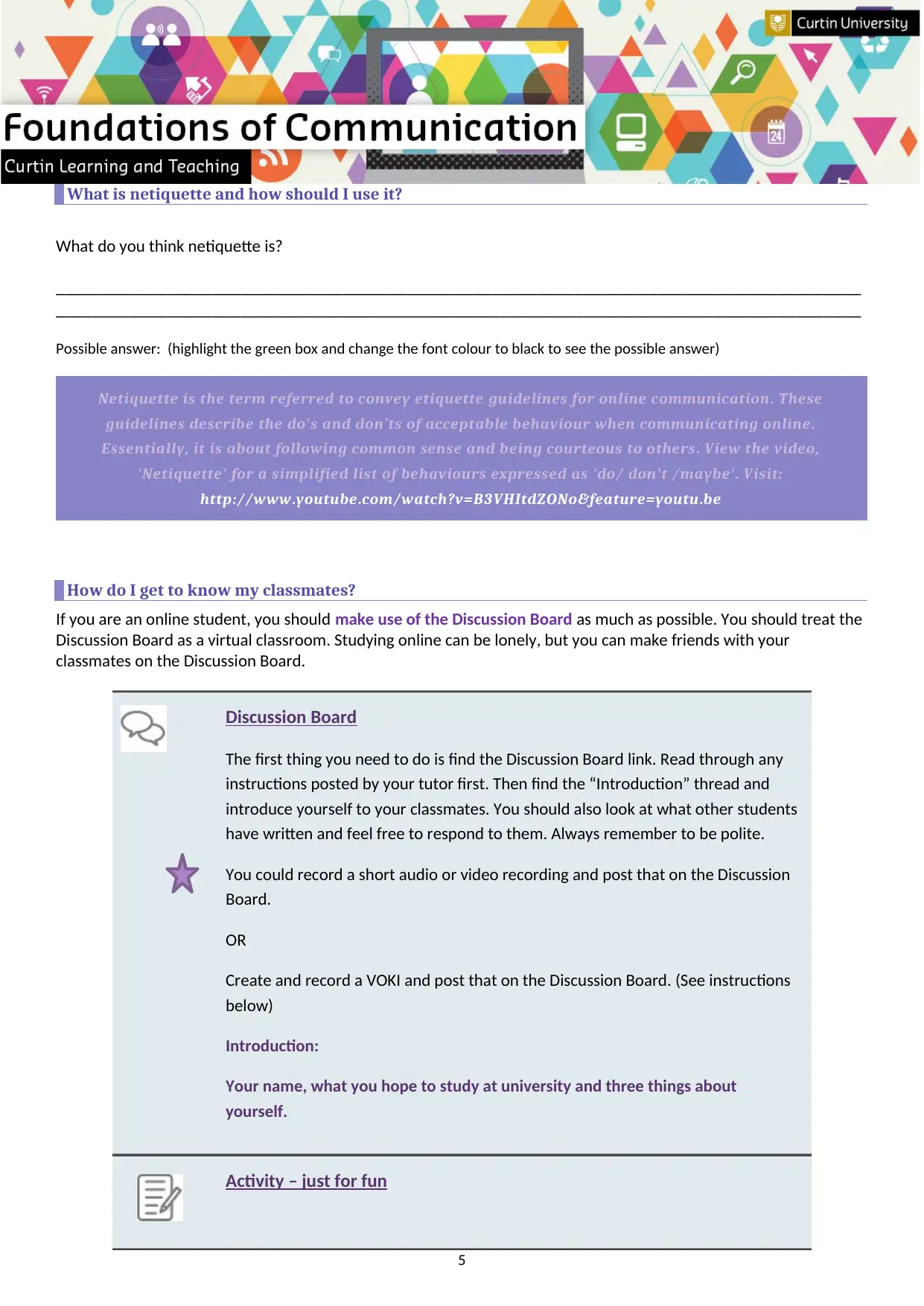
What is netiquette and how should I use it?
What do you think netiquette is?
_______________________________________________________________________________________
_______________________________________________________________________________________
Possible answer: (highlight the green box and change the font colour to black to see the possible answer)
Netiquette is the term referred to convey etiquette guidelines for online communication. These
guidelines describe the do's and don’ts of acceptable behaviour when communicating online.
Essentially, it is about following common sense and being courteous to others. View the video,
'Netiquette' for a simplified list of behaviours expressed as 'do/ don't /maybe'. Visit:
http://www.youtube.com/watch?v=B3VHItdZONo&feature=youtu.be
How do I get to know my classmates?
If you are an online student, you should make use of the Discussion Board as much as possible. You should treat the
Discussion Board as a virtual classroom. Studying online can be lonely, but you can make friends with your
classmates on the Discussion Board.
Discussion Board
The first thing you need to do is find the Discussion Board link. Read through any
instructions posted by your tutor first. Then find the “Introduction” thread and
introduce yourself to your classmates. You should also look at what other students
have written and feel free to respond to them. Always remember to be polite.
You could record a short audio or video recording and post that on the Discussion
Board.
OR
Create and record a VOKI and post that on the Discussion Board. (See instructions
below)
Introduction:
Your name, what you hope to study at university and three things about
yourself.
Activity – just for fun
5
What do you think netiquette is?
_______________________________________________________________________________________
_______________________________________________________________________________________
Possible answer: (highlight the green box and change the font colour to black to see the possible answer)
Netiquette is the term referred to convey etiquette guidelines for online communication. These
guidelines describe the do's and don’ts of acceptable behaviour when communicating online.
Essentially, it is about following common sense and being courteous to others. View the video,
'Netiquette' for a simplified list of behaviours expressed as 'do/ don't /maybe'. Visit:
http://www.youtube.com/watch?v=B3VHItdZONo&feature=youtu.be
How do I get to know my classmates?
If you are an online student, you should make use of the Discussion Board as much as possible. You should treat the
Discussion Board as a virtual classroom. Studying online can be lonely, but you can make friends with your
classmates on the Discussion Board.
Discussion Board
The first thing you need to do is find the Discussion Board link. Read through any
instructions posted by your tutor first. Then find the “Introduction” thread and
introduce yourself to your classmates. You should also look at what other students
have written and feel free to respond to them. Always remember to be polite.
You could record a short audio or video recording and post that on the Discussion
Board.
OR
Create and record a VOKI and post that on the Discussion Board. (See instructions
below)
Introduction:
Your name, what you hope to study at university and three things about
yourself.
Activity – just for fun
5
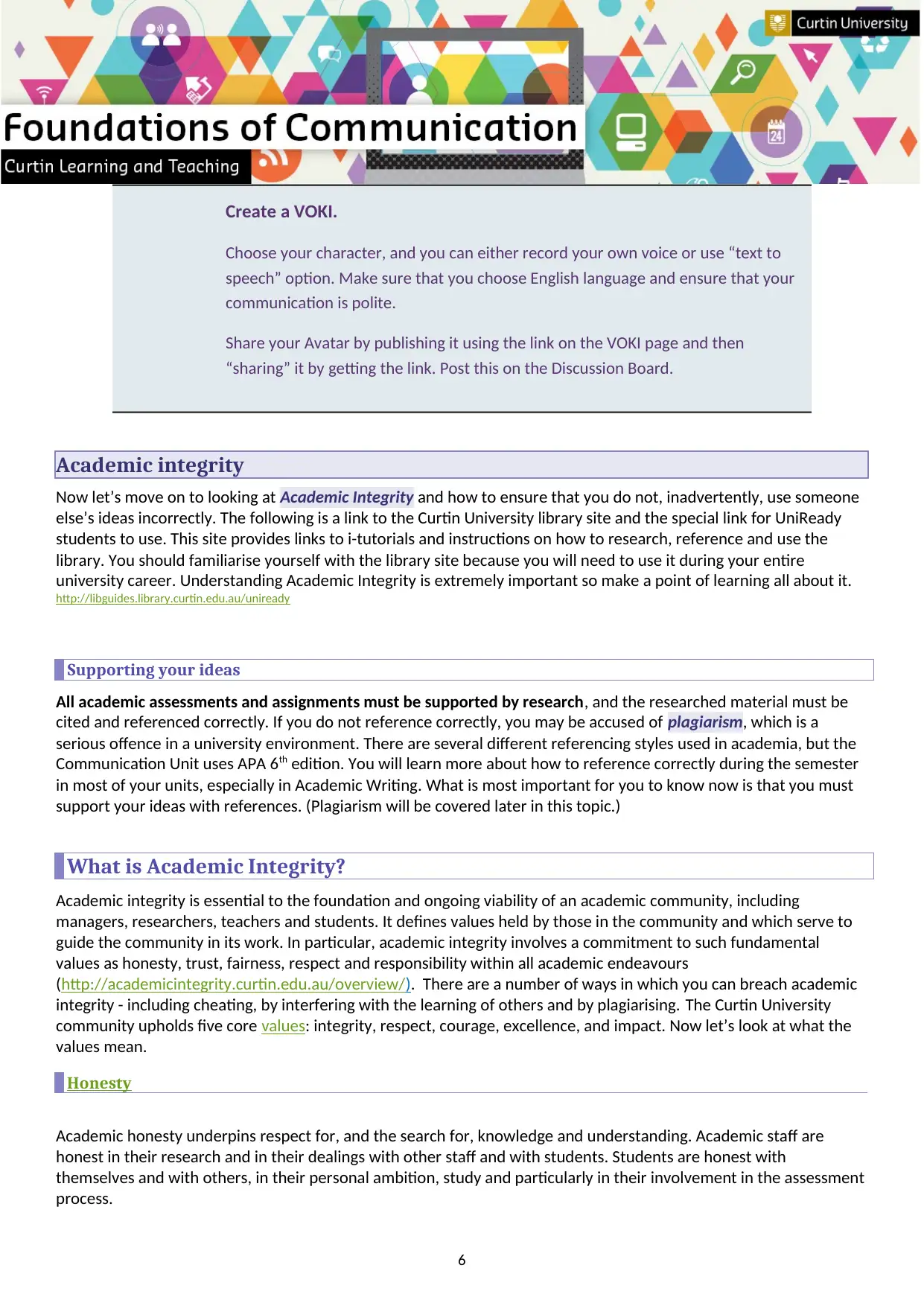
Create a VOKI.
Choose your character, and you can either record your own voice or use “text to
speech” option. Make sure that you choose English language and ensure that your
communication is polite.
Share your Avatar by publishing it using the link on the VOKI page and then
“sharing” it by getting the link. Post this on the Discussion Board.
Academic integrity
Now let’s move on to looking at Academic Integrity and how to ensure that you do not, inadvertently, use someone
else’s ideas incorrectly. The following is a link to the Curtin University library site and the special link for UniReady
students to use. This site provides links to i-tutorials and instructions on how to research, reference and use the
library. You should familiarise yourself with the library site because you will need to use it during your entire
university career. Understanding Academic Integrity is extremely important so make a point of learning all about it.
http://libguides.library.curtin.edu.au/uniready
Supporting your ideas
All academic assessments and assignments must be supported by research, and the researched material must be
cited and referenced correctly. If you do not reference correctly, you may be accused of plagiarism, which is a
serious offence in a university environment. There are several different referencing styles used in academia, but the
Communication Unit uses APA 6th edition. You will learn more about how to reference correctly during the semester
in most of your units, especially in Academic Writing. What is most important for you to know now is that you must
support your ideas with references. (Plagiarism will be covered later in this topic.)
What is Academic Integrity?
Academic integrity is essential to the foundation and ongoing viability of an academic community, including
managers, researchers, teachers and students. It defines values held by those in the community and which serve to
guide the community in its work. In particular, academic integrity involves a commitment to such fundamental
values as honesty, trust, fairness, respect and responsibility within all academic endeavours
(http://academicintegrity.curtin.edu.au/overview/). There are a number of ways in which you can breach academic
integrity - including cheating, by interfering with the learning of others and by plagiarising. The Curtin University
community upholds five core values: integrity, respect, courage, excellence, and impact. Now let’s look at what the
values mean.
Honesty
Academic honesty underpins respect for, and the search for, knowledge and understanding. Academic staff are
honest in their research and in their dealings with other staff and with students. Students are honest with
themselves and with others, in their personal ambition, study and particularly in their involvement in the assessment
process.
6
Choose your character, and you can either record your own voice or use “text to
speech” option. Make sure that you choose English language and ensure that your
communication is polite.
Share your Avatar by publishing it using the link on the VOKI page and then
“sharing” it by getting the link. Post this on the Discussion Board.
Academic integrity
Now let’s move on to looking at Academic Integrity and how to ensure that you do not, inadvertently, use someone
else’s ideas incorrectly. The following is a link to the Curtin University library site and the special link for UniReady
students to use. This site provides links to i-tutorials and instructions on how to research, reference and use the
library. You should familiarise yourself with the library site because you will need to use it during your entire
university career. Understanding Academic Integrity is extremely important so make a point of learning all about it.
http://libguides.library.curtin.edu.au/uniready
Supporting your ideas
All academic assessments and assignments must be supported by research, and the researched material must be
cited and referenced correctly. If you do not reference correctly, you may be accused of plagiarism, which is a
serious offence in a university environment. There are several different referencing styles used in academia, but the
Communication Unit uses APA 6th edition. You will learn more about how to reference correctly during the semester
in most of your units, especially in Academic Writing. What is most important for you to know now is that you must
support your ideas with references. (Plagiarism will be covered later in this topic.)
What is Academic Integrity?
Academic integrity is essential to the foundation and ongoing viability of an academic community, including
managers, researchers, teachers and students. It defines values held by those in the community and which serve to
guide the community in its work. In particular, academic integrity involves a commitment to such fundamental
values as honesty, trust, fairness, respect and responsibility within all academic endeavours
(http://academicintegrity.curtin.edu.au/overview/). There are a number of ways in which you can breach academic
integrity - including cheating, by interfering with the learning of others and by plagiarising. The Curtin University
community upholds five core values: integrity, respect, courage, excellence, and impact. Now let’s look at what the
values mean.
Honesty
Academic honesty underpins respect for, and the search for, knowledge and understanding. Academic staff are
honest in their research and in their dealings with other staff and with students. Students are honest with
themselves and with others, in their personal ambition, study and particularly in their involvement in the assessment
process.
6
⊘ This is a preview!⊘
Do you want full access?
Subscribe today to unlock all pages.

Trusted by 1+ million students worldwide
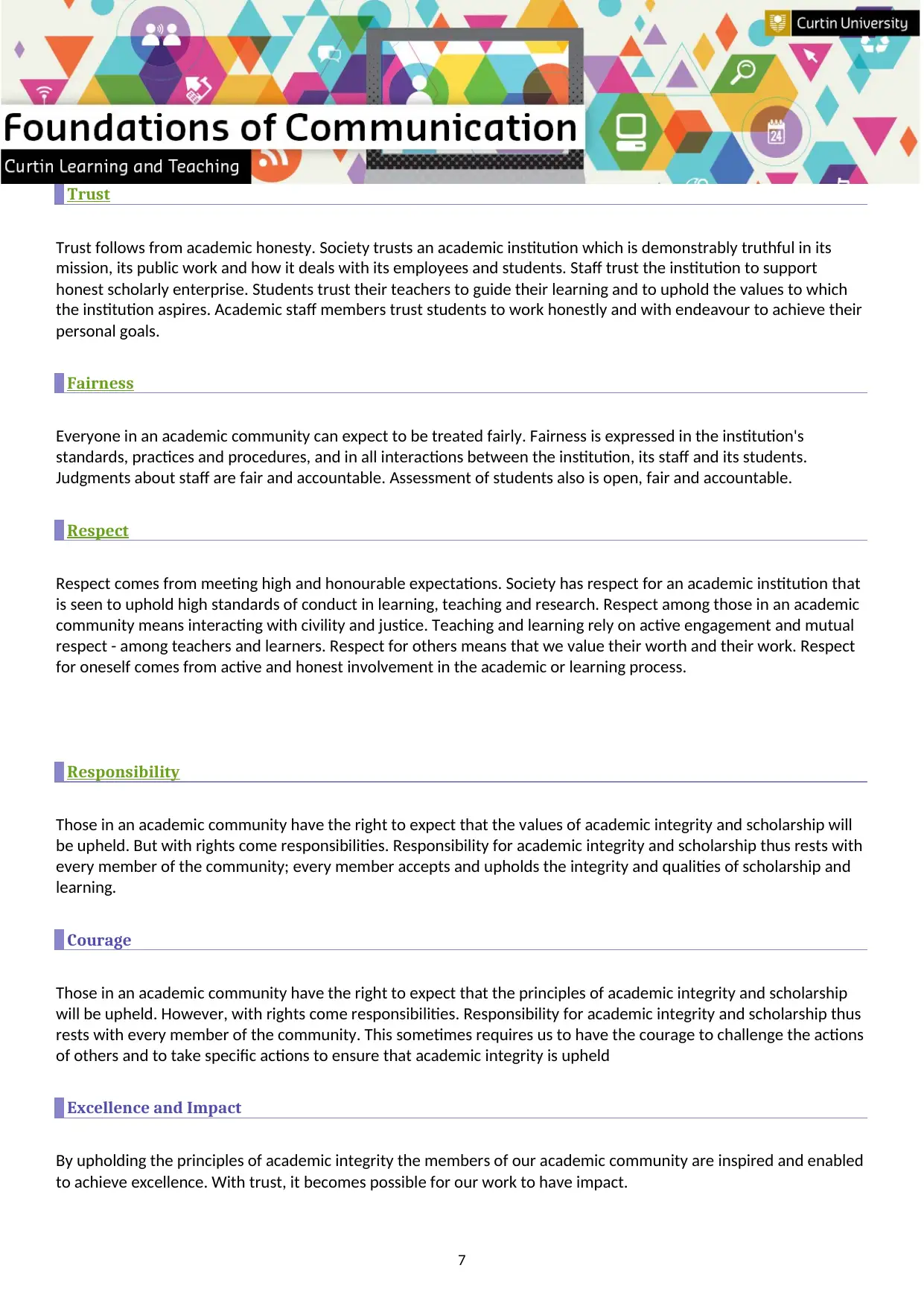
Trust
Trust follows from academic honesty. Society trusts an academic institution which is demonstrably truthful in its
mission, its public work and how it deals with its employees and students. Staff trust the institution to support
honest scholarly enterprise. Students trust their teachers to guide their learning and to uphold the values to which
the institution aspires. Academic staff members trust students to work honestly and with endeavour to achieve their
personal goals.
Fairness
Everyone in an academic community can expect to be treated fairly. Fairness is expressed in the institution's
standards, practices and procedures, and in all interactions between the institution, its staff and its students.
Judgments about staff are fair and accountable. Assessment of students also is open, fair and accountable.
Respect
Respect comes from meeting high and honourable expectations. Society has respect for an academic institution that
is seen to uphold high standards of conduct in learning, teaching and research. Respect among those in an academic
community means interacting with civility and justice. Teaching and learning rely on active engagement and mutual
respect - among teachers and learners. Respect for others means that we value their worth and their work. Respect
for oneself comes from active and honest involvement in the academic or learning process.
Responsibility
Those in an academic community have the right to expect that the values of academic integrity and scholarship will
be upheld. But with rights come responsibilities. Responsibility for academic integrity and scholarship thus rests with
every member of the community; every member accepts and upholds the integrity and qualities of scholarship and
learning.
Courage
Those in an academic community have the right to expect that the principles of academic integrity and scholarship
will be upheld. However, with rights come responsibilities. Responsibility for academic integrity and scholarship thus
rests with every member of the community. This sometimes requires us to have the courage to challenge the actions
of others and to take specific actions to ensure that academic integrity is upheld
Excellence and Impact
By upholding the principles of academic integrity the members of our academic community are inspired and enabled
to achieve excellence. With trust, it becomes possible for our work to have impact.
7
Trust follows from academic honesty. Society trusts an academic institution which is demonstrably truthful in its
mission, its public work and how it deals with its employees and students. Staff trust the institution to support
honest scholarly enterprise. Students trust their teachers to guide their learning and to uphold the values to which
the institution aspires. Academic staff members trust students to work honestly and with endeavour to achieve their
personal goals.
Fairness
Everyone in an academic community can expect to be treated fairly. Fairness is expressed in the institution's
standards, practices and procedures, and in all interactions between the institution, its staff and its students.
Judgments about staff are fair and accountable. Assessment of students also is open, fair and accountable.
Respect
Respect comes from meeting high and honourable expectations. Society has respect for an academic institution that
is seen to uphold high standards of conduct in learning, teaching and research. Respect among those in an academic
community means interacting with civility and justice. Teaching and learning rely on active engagement and mutual
respect - among teachers and learners. Respect for others means that we value their worth and their work. Respect
for oneself comes from active and honest involvement in the academic or learning process.
Responsibility
Those in an academic community have the right to expect that the values of academic integrity and scholarship will
be upheld. But with rights come responsibilities. Responsibility for academic integrity and scholarship thus rests with
every member of the community; every member accepts and upholds the integrity and qualities of scholarship and
learning.
Courage
Those in an academic community have the right to expect that the principles of academic integrity and scholarship
will be upheld. However, with rights come responsibilities. Responsibility for academic integrity and scholarship thus
rests with every member of the community. This sometimes requires us to have the courage to challenge the actions
of others and to take specific actions to ensure that academic integrity is upheld
Excellence and Impact
By upholding the principles of academic integrity the members of our academic community are inspired and enabled
to achieve excellence. With trust, it becomes possible for our work to have impact.
7
Paraphrase This Document
Need a fresh take? Get an instant paraphrase of this document with our AI Paraphraser
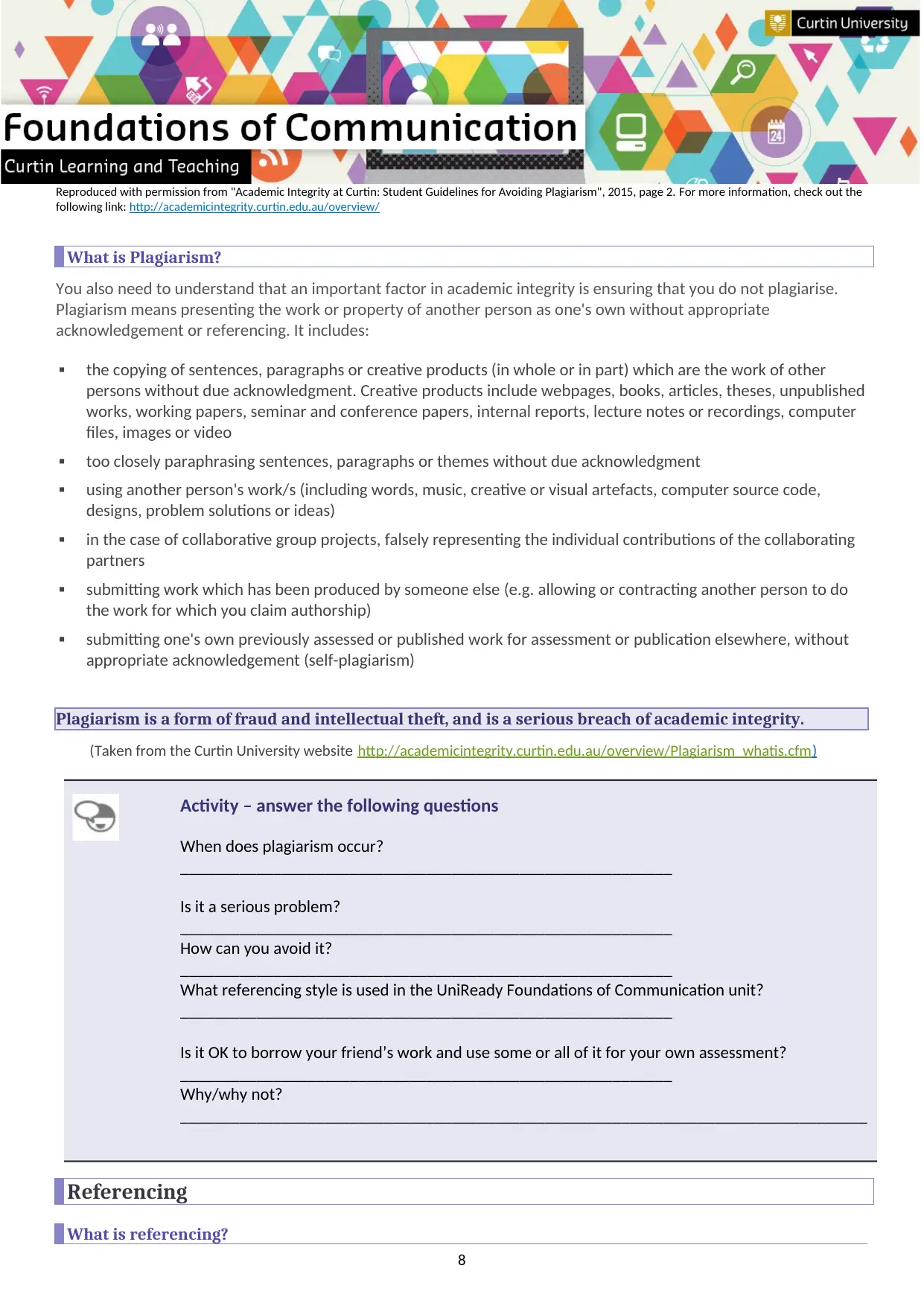
Reproduced with permission from "Academic Integrity at Curtin: Student Guidelines for Avoiding Plagiarism", 2015, page 2. For more information, check out the
following link: http://academicintegrity.curtin.edu.au/overview/
What is Plagiarism?
You also need to understand that an important factor in academic integrity is ensuring that you do not plagiarise.
Plagiarism means presenting the work or property of another person as one's own without appropriate
acknowledgement or referencing. It includes:
the copying of sentences, paragraphs or creative products (in whole or in part) which are the work of other
persons without due acknowledgment. Creative products include webpages, books, articles, theses, unpublished
works, working papers, seminar and conference papers, internal reports, lecture notes or recordings, computer
files, images or video
too closely paraphrasing sentences, paragraphs or themes without due acknowledgment
using another person's work/s (including words, music, creative or visual artefacts, computer source code,
designs, problem solutions or ideas)
in the case of collaborative group projects, falsely representing the individual contributions of the collaborating
partners
submitting work which has been produced by someone else (e.g. allowing or contracting another person to do
the work for which you claim authorship)
submitting one's own previously assessed or published work for assessment or publication elsewhere, without
appropriate acknowledgement (self-plagiarism)
Plagiarism is a form of fraud and intellectual theft, and is a serious breach of academic integrity.
(Taken from the Curtin University website http://academicintegrity.curtin.edu.au/overview/Plagiarism_whatis.cfm)
Activity – answer the following questions
When does plagiarism occur?
__________________________________________________________
Is it a serious problem?
__________________________________________________________
How can you avoid it?
__________________________________________________________
What referencing style is used in the UniReady Foundations of Communication unit?
__________________________________________________________
Is it OK to borrow your friend’s work and use some or all of it for your own assessment?
__________________________________________________________
Why/why not?
_________________________________________________________________________________
Referencing
What is referencing?
8
following link: http://academicintegrity.curtin.edu.au/overview/
What is Plagiarism?
You also need to understand that an important factor in academic integrity is ensuring that you do not plagiarise.
Plagiarism means presenting the work or property of another person as one's own without appropriate
acknowledgement or referencing. It includes:
the copying of sentences, paragraphs or creative products (in whole or in part) which are the work of other
persons without due acknowledgment. Creative products include webpages, books, articles, theses, unpublished
works, working papers, seminar and conference papers, internal reports, lecture notes or recordings, computer
files, images or video
too closely paraphrasing sentences, paragraphs or themes without due acknowledgment
using another person's work/s (including words, music, creative or visual artefacts, computer source code,
designs, problem solutions or ideas)
in the case of collaborative group projects, falsely representing the individual contributions of the collaborating
partners
submitting work which has been produced by someone else (e.g. allowing or contracting another person to do
the work for which you claim authorship)
submitting one's own previously assessed or published work for assessment or publication elsewhere, without
appropriate acknowledgement (self-plagiarism)
Plagiarism is a form of fraud and intellectual theft, and is a serious breach of academic integrity.
(Taken from the Curtin University website http://academicintegrity.curtin.edu.au/overview/Plagiarism_whatis.cfm)
Activity – answer the following questions
When does plagiarism occur?
__________________________________________________________
Is it a serious problem?
__________________________________________________________
How can you avoid it?
__________________________________________________________
What referencing style is used in the UniReady Foundations of Communication unit?
__________________________________________________________
Is it OK to borrow your friend’s work and use some or all of it for your own assessment?
__________________________________________________________
Why/why not?
_________________________________________________________________________________
Referencing
What is referencing?
8
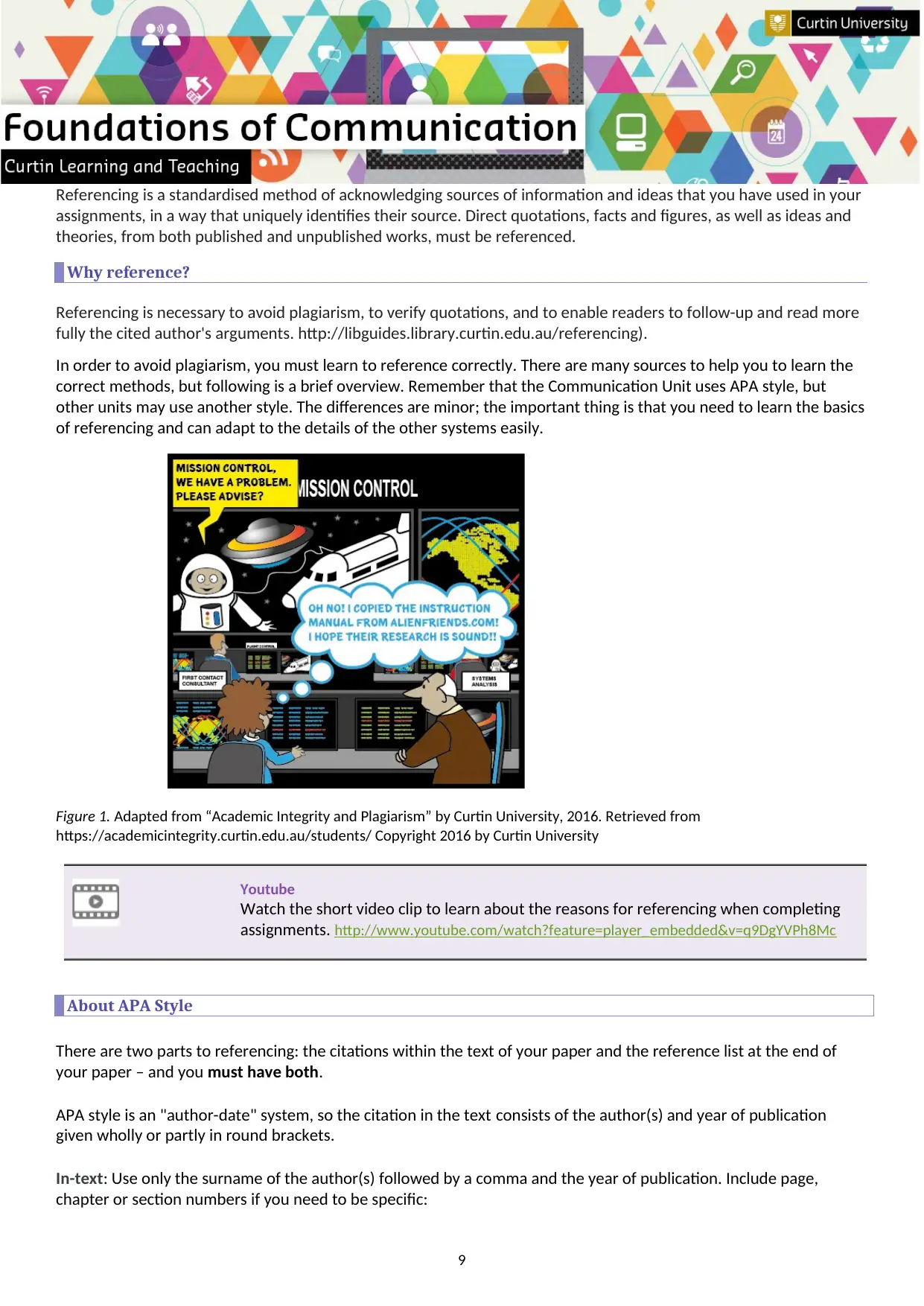
Referencing is a standardised method of acknowledging sources of information and ideas that you have used in your
assignments, in a way that uniquely identifies their source. Direct quotations, facts and figures, as well as ideas and
theories, from both published and unpublished works, must be referenced.
Why reference?
Referencing is necessary to avoid plagiarism, to verify quotations, and to enable readers to follow-up and read more
fully the cited author's arguments. http://libguides.library.curtin.edu.au/referencing).
In order to avoid plagiarism, you must learn to reference correctly. There are many sources to help you to learn the
correct methods, but following is a brief overview. Remember that the Communication Unit uses APA style, but
other units may use another style. The differences are minor; the important thing is that you need to learn the basics
of referencing and can adapt to the details of the other systems easily.
Figure 1. Adapted from “Academic Integrity and Plagiarism” by Curtin University, 2016. Retrieved from
https://academicintegrity.curtin.edu.au/students/ Copyright 2016 by Curtin University
Youtube
Watch the short video clip to learn about the reasons for referencing when completing
assignments. http://www.youtube.com/watch?feature=player_embedded&v=q9DgYVPh8Mc
About APA Style
There are two parts to referencing: the citations within the text of your paper and the reference list at the end of
your paper – and you must have both.
APA style is an "author-date" system, so the citation in the text consists of the author(s) and year of publication
given wholly or partly in round brackets.
In-text: Use only the surname of the author(s) followed by a comma and the year of publication. Include page,
chapter or section numbers if you need to be specific:
9
assignments, in a way that uniquely identifies their source. Direct quotations, facts and figures, as well as ideas and
theories, from both published and unpublished works, must be referenced.
Why reference?
Referencing is necessary to avoid plagiarism, to verify quotations, and to enable readers to follow-up and read more
fully the cited author's arguments. http://libguides.library.curtin.edu.au/referencing).
In order to avoid plagiarism, you must learn to reference correctly. There are many sources to help you to learn the
correct methods, but following is a brief overview. Remember that the Communication Unit uses APA style, but
other units may use another style. The differences are minor; the important thing is that you need to learn the basics
of referencing and can adapt to the details of the other systems easily.
Figure 1. Adapted from “Academic Integrity and Plagiarism” by Curtin University, 2016. Retrieved from
https://academicintegrity.curtin.edu.au/students/ Copyright 2016 by Curtin University
Youtube
Watch the short video clip to learn about the reasons for referencing when completing
assignments. http://www.youtube.com/watch?feature=player_embedded&v=q9DgYVPh8Mc
About APA Style
There are two parts to referencing: the citations within the text of your paper and the reference list at the end of
your paper – and you must have both.
APA style is an "author-date" system, so the citation in the text consists of the author(s) and year of publication
given wholly or partly in round brackets.
In-text: Use only the surname of the author(s) followed by a comma and the year of publication. Include page,
chapter or section numbers if you need to be specific:
9
⊘ This is a preview!⊘
Do you want full access?
Subscribe today to unlock all pages.

Trusted by 1+ million students worldwide
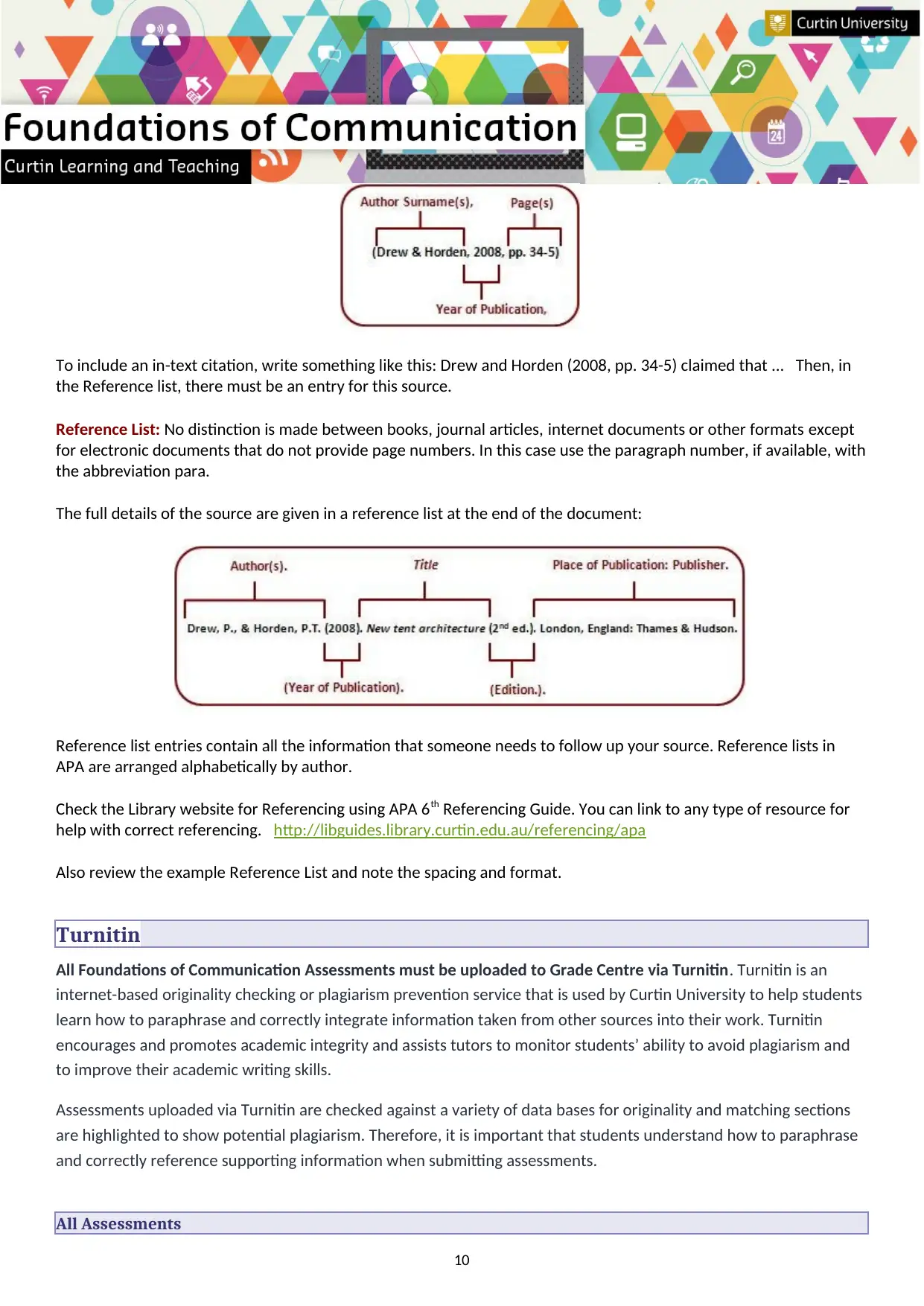
To include an in-text citation, write something like this: Drew and Horden (2008, pp. 34-5) claimed that ... Then, in
the Reference list, there must be an entry for this source.
Reference List: No distinction is made between books, journal articles, internet documents or other formats except
for electronic documents that do not provide page numbers. In this case use the paragraph number, if available, with
the abbreviation para.
The full details of the source are given in a reference list at the end of the document:
Reference list entries contain all the information that someone needs to follow up your source. Reference lists in
APA are arranged alphabetically by author.
Check the Library website for Referencing using APA 6th Referencing Guide. You can link to any type of resource for
help with correct referencing. http://libguides.library.curtin.edu.au/referencing/apa
Also review the example Reference List and note the spacing and format.
Turnitin
All Foundations of Communication Assessments must be uploaded to Grade Centre via Turnitin. Turnitin is an
internet-based originality checking or plagiarism prevention service that is used by Curtin University to help students
learn how to paraphrase and correctly integrate information taken from other sources into their work. Turnitin
encourages and promotes academic integrity and assists tutors to monitor students’ ability to avoid plagiarism and
to improve their academic writing skills.
Assessments uploaded via Turnitin are checked against a variety of data bases for originality and matching sections
are highlighted to show potential plagiarism. Therefore, it is important that students understand how to paraphrase
and correctly reference supporting information when submitting assessments.
All Assessments
10
the Reference list, there must be an entry for this source.
Reference List: No distinction is made between books, journal articles, internet documents or other formats except
for electronic documents that do not provide page numbers. In this case use the paragraph number, if available, with
the abbreviation para.
The full details of the source are given in a reference list at the end of the document:
Reference list entries contain all the information that someone needs to follow up your source. Reference lists in
APA are arranged alphabetically by author.
Check the Library website for Referencing using APA 6th Referencing Guide. You can link to any type of resource for
help with correct referencing. http://libguides.library.curtin.edu.au/referencing/apa
Also review the example Reference List and note the spacing and format.
Turnitin
All Foundations of Communication Assessments must be uploaded to Grade Centre via Turnitin. Turnitin is an
internet-based originality checking or plagiarism prevention service that is used by Curtin University to help students
learn how to paraphrase and correctly integrate information taken from other sources into their work. Turnitin
encourages and promotes academic integrity and assists tutors to monitor students’ ability to avoid plagiarism and
to improve their academic writing skills.
Assessments uploaded via Turnitin are checked against a variety of data bases for originality and matching sections
are highlighted to show potential plagiarism. Therefore, it is important that students understand how to paraphrase
and correctly reference supporting information when submitting assessments.
All Assessments
10
Paraphrase This Document
Need a fresh take? Get an instant paraphrase of this document with our AI Paraphraser
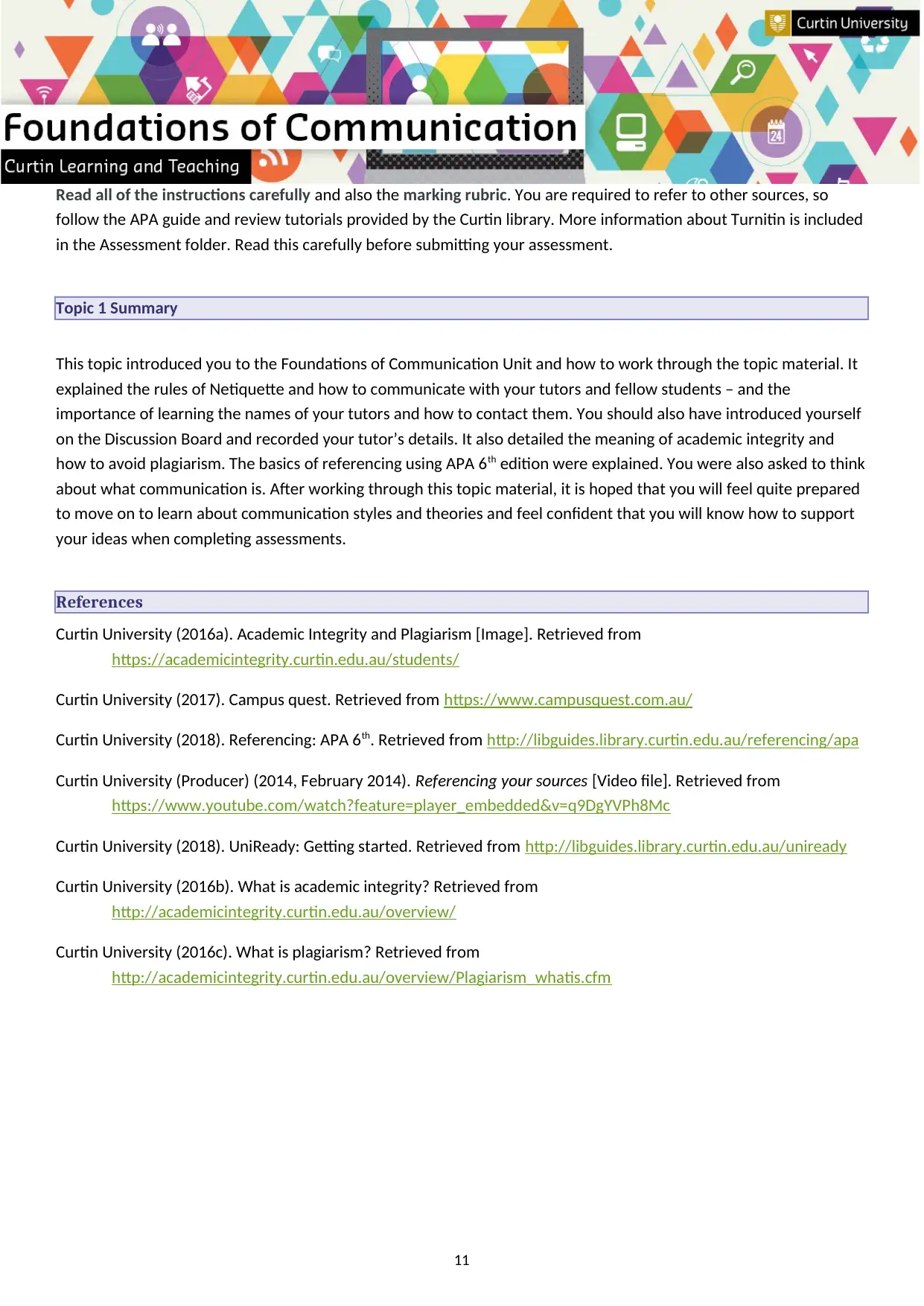
Read all of the instructions carefully and also the marking rubric. You are required to refer to other sources, so
follow the APA guide and review tutorials provided by the Curtin library. More information about Turnitin is included
in the Assessment folder. Read this carefully before submitting your assessment.
Topic 1 Summary
This topic introduced you to the Foundations of Communication Unit and how to work through the topic material. It
explained the rules of Netiquette and how to communicate with your tutors and fellow students – and the
importance of learning the names of your tutors and how to contact them. You should also have introduced yourself
on the Discussion Board and recorded your tutor’s details. It also detailed the meaning of academic integrity and
how to avoid plagiarism. The basics of referencing using APA 6th edition were explained. You were also asked to think
about what communication is. After working through this topic material, it is hoped that you will feel quite prepared
to move on to learn about communication styles and theories and feel confident that you will know how to support
your ideas when completing assessments.
References
Curtin University (2016a). Academic Integrity and Plagiarism [Image]. Retrieved from
https://academicintegrity.curtin.edu.au/students/
Curtin University (2017). Campus quest. Retrieved from https://www.campusquest.com.au/
Curtin University (2018). Referencing: APA 6th. Retrieved from http://libguides.library.curtin.edu.au/referencing/apa
Curtin University (Producer) (2014, February 2014). Referencing your sources [Video file]. Retrieved from
https://www.youtube.com/watch?feature=player_embedded&v=q9DgYVPh8Mc
Curtin University (2018). UniReady: Getting started. Retrieved from http://libguides.library.curtin.edu.au/uniready
Curtin University (2016b). What is academic integrity? Retrieved from
http://academicintegrity.curtin.edu.au/overview/
Curtin University (2016c). What is plagiarism? Retrieved from
http://academicintegrity.curtin.edu.au/overview/Plagiarism_whatis.cfm
11
follow the APA guide and review tutorials provided by the Curtin library. More information about Turnitin is included
in the Assessment folder. Read this carefully before submitting your assessment.
Topic 1 Summary
This topic introduced you to the Foundations of Communication Unit and how to work through the topic material. It
explained the rules of Netiquette and how to communicate with your tutors and fellow students – and the
importance of learning the names of your tutors and how to contact them. You should also have introduced yourself
on the Discussion Board and recorded your tutor’s details. It also detailed the meaning of academic integrity and
how to avoid plagiarism. The basics of referencing using APA 6th edition were explained. You were also asked to think
about what communication is. After working through this topic material, it is hoped that you will feel quite prepared
to move on to learn about communication styles and theories and feel confident that you will know how to support
your ideas when completing assessments.
References
Curtin University (2016a). Academic Integrity and Plagiarism [Image]. Retrieved from
https://academicintegrity.curtin.edu.au/students/
Curtin University (2017). Campus quest. Retrieved from https://www.campusquest.com.au/
Curtin University (2018). Referencing: APA 6th. Retrieved from http://libguides.library.curtin.edu.au/referencing/apa
Curtin University (Producer) (2014, February 2014). Referencing your sources [Video file]. Retrieved from
https://www.youtube.com/watch?feature=player_embedded&v=q9DgYVPh8Mc
Curtin University (2018). UniReady: Getting started. Retrieved from http://libguides.library.curtin.edu.au/uniready
Curtin University (2016b). What is academic integrity? Retrieved from
http://academicintegrity.curtin.edu.au/overview/
Curtin University (2016c). What is plagiarism? Retrieved from
http://academicintegrity.curtin.edu.au/overview/Plagiarism_whatis.cfm
11
1 out of 11
Related Documents
Your All-in-One AI-Powered Toolkit for Academic Success.
+13062052269
info@desklib.com
Available 24*7 on WhatsApp / Email
![[object Object]](/_next/static/media/star-bottom.7253800d.svg)
Unlock your academic potential
Copyright © 2020–2025 A2Z Services. All Rights Reserved. Developed and managed by ZUCOL.



